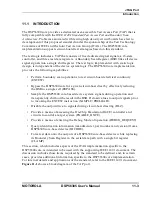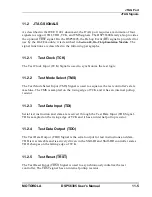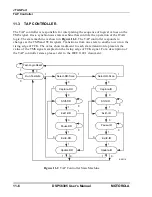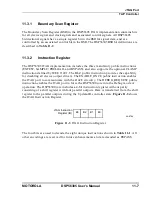
JTAG Port
TAP Controller
MOTOROLA
DSP56305 User’s Manual
11-11
Register, the required guarding signals would be loaded as part of the complete serial
data stream shifted in, both at the start of the test and each time a new test pattern is
entered. Since the CLAMP instruction allows guarding values to be applied using the
Boundary Scan Register of the appropriate ICs while selecting their Bypass registers, it
allows much faster testing than does the EXTEST instruction. Data in the boundary scan
cell remains unchanged until a new instruction is shifted in or the JTAG state machine is
set to its reset state. The CLAMP instruction also asserts internal reset for the DSP56300
core system logic to force a predictable internal state while performing external
boundary scan operations.
11.3.2.5
HI-Z (B[3:0] = 0100)
The HI-Z instruction is not included in the IEEE 1149.1 standard. It is provided as a
manufacturer’s optional public instruction to prevent having to backdrive the output
signals during circuit-board testing. When HI-Z is invoked, all output drivers, including
the two-state drivers, are turned off (i.e., high impedance). The instruction selects the
Bypass register. The HI-Z instruction also asserts internal reset for the DSP56300 core
system logic to force a predictable internal state while performing external boundary
scan operations
11.3.2.6
ENABLE_ONCE(B[3:0] = 0110)
The ENABLE_ONCE instruction is not included in the IEEE 1149.1 standard. It is
provided as a public instruction to allow the user to perform system debug functions.
When the ENABLE_ONCE instruction is decoded the TDI and TDO signals are
connected directly to the OnCE registers. The particular OnCE register connected
between TDI and TDO at a given time is selected by the OnCE controller depending on
the OnCE instruction currently being executed. All communication with the OnCE
controller is done through the Select-DR-Scan path of the JTAG TAP Controller.
See
Section 10, On-Chip Emulation (OnCE)
, for more information.
11.3.2.7
DEBUG_REQUEST(B[3:0] = 0111)
The DEBUG_REQUEST instruction is not included in the IEEE 1149.1 standard. It is
provided as a public instruction to allow the user to generate a debug request signal to
the DSP56300 core. When the DEBUG_REQUEST instruction is decoded, the TDI and
TDO signals are connected to the Instruction Registers. Due to the fact that in the
Capture-IR state of the TAP the OnCE status bits are captured in the Instruction shift
register, the external JTAG controller must continue to shift-in the DEBUG_REQUEST
instruction while polling the status bits that are shifted-out until the Debug mode of
operation is entered (acknowledged by the combination 11 on OS1–OS0). After
acknowledgment of the Debug mode is received, the external JTAG controller must issue
the ENABLE_ONCE instruction to allow the user to perform system debug functions.
Summary of Contents for DSP56305
Page 34: ...xxxii DSP56305 User s Manual MOTOROLA ...
Page 40: ...xxxvi DSP56305 User s Manual MOTOROLA ...
Page 41: ...MOTOROLA DSP56305 User s Manual 1 1 SECTION 1 DSP56305 OVERVIEW ...
Page 58: ...1 18 DSP56305 User s Manual MOTOROLA DSP56305 Overview DSP56305 Architecture Overview ...
Page 59: ...MOTOROLA DSP56305 User s Manual 2 1 SECTION 2 SIGNAL CONNECTION DESCRIPTIONS ...
Page 98: ...2 40 DSP56305 User s Manual MOTOROLA Signal Connection Descriptions JTAG OnCE Interface ...
Page 99: ...MOTOROLA DSP56305 User s Manual 3 1 SECTION 3 MEMORY CONFIGURATION ...
Page 119: ...MOTOROLA DSP56305 User s Manual 4 1 SECTION 4 CORE CONFIGURATION ...
Page 144: ...4 26 DSP56305 User s Manual MOTOROLA Core Configuration JTAG Boundary Scan Register BSR ...
Page 145: ...MOTOROLA DSP56305 User s Manual 5 1 SECTION 5 GENERAL PURPOSE I O ...
Page 149: ...HOST INTERFACE HI32 MOTOROLA DSP56305 User s Manual 6 1 SECTION 6 HOST INTERFACE HI32 ...
Page 150: ...6 2 DSP56305 User s Manual MOTOROLA HOST INTERFACE HI32 ...
Page 259: ...MOTOROLA DSP56305 User s Manual 7 1 SECTION 7 ENHANCED SYNCHRONOUS SERIAL INTERFACE ESSI ...
Page 315: ...MOTOROLA DSP56305 User s Manual 8 1 SECTION 8 SERIAL COMMUNICATION INTERFACE SCI ...
Page 347: ...MOTOROLA DSP56305 User s Manual 9 1 SECTION 9 TIMER EVENT COUNTER ...
Page 376: ...9 30 DSP56305 User s Manual MOTOROLA Timer Event Counter Timer Modes of Operation ...
Page 377: ...MOTOROLA DSP56305 User s Manual 10 1 SECTION 10 ON CHIP EMULATION MODULE ...
Page 411: ...MOTOROLA DSP56305 User s Manual 11 1 SECTION 11 JTAG PORT ...
Page 430: ...11 20 DSP56305 User s Manual MOTOROLA JTAG Port DSP56305 Boundary Scan Register ...
Page 431: ...Filter Co Processor MOTOROLA DSP56305 User s Manual 12 1 SECTION 12 FILTER CO PROCESSOR ...
Page 471: ...VITERBI CO PROCESSOR MOTOROLA DSP56305 User s Manual 13 1 SECTION 13 VITERBI CO PROCESSOR ...
Page 522: ...13 52 DSP56305 User s Manual MOTOROLA VITERBI CO PROCESSOR References ...
Page 554: ...14 32 DSP56305 User s Manual MOTOROLA CYCLIC CODE CO PROCESSOR Configuration Examples ...
Page 555: ...MOTOROLA DSP56305 User s Manual A 1 APPENDIX A BOOTSTRAP CODE ...
Page 568: ...A 14 DSP56305 User s Manual MOTOROLA Bootstrap Code ...
Page 569: ...Equates MOTOROLA DSP56305 User s Manual B 1 APPENDIX B EQUATES ...
Page 589: ...MOTOROLA DSP56305 User s Manual C 1 APPENDIX C JTAG BSDL ...
Page 590: ...C 2 DSP56305 User s Manual MOTOROLA JTAG BSDL ...
Page 600: ...C 12 DSP56305 User s Manual MOTOROLA JTAG BSDL ...
Page 601: ...MOTOROLA DSP56305 User s Manual D 1 APPENDIX D PROGRAMMING REFERENCE ...
Page 602: ...D 2 DSP56305 User s Manual MOTOROLA PROGRAMMING REFERENCE ...
Page 661: ...Y MOTOROLA DSP56305 User s Manual Index 11 ...
Page 662: ...Y Index 12 DSP56305 User s Manual MOTOROLA ...
















































